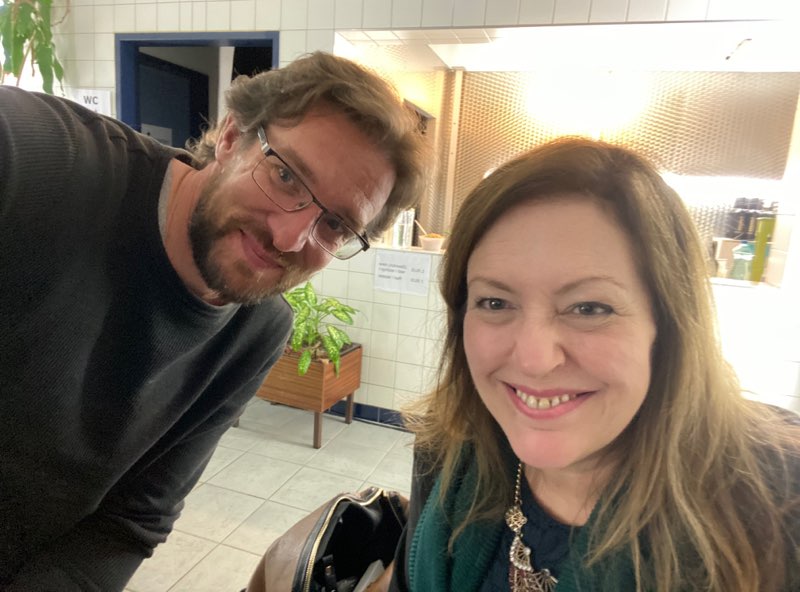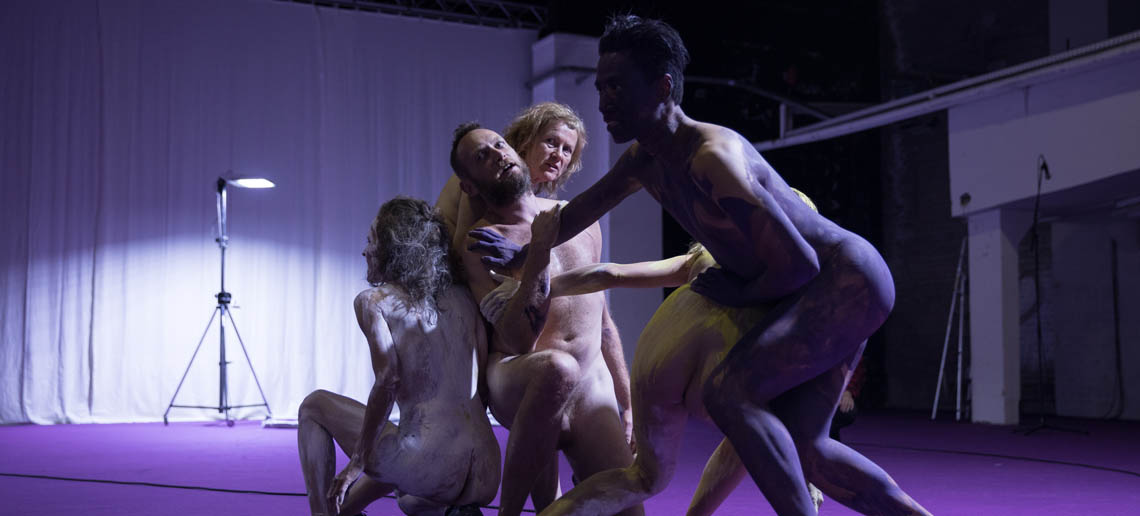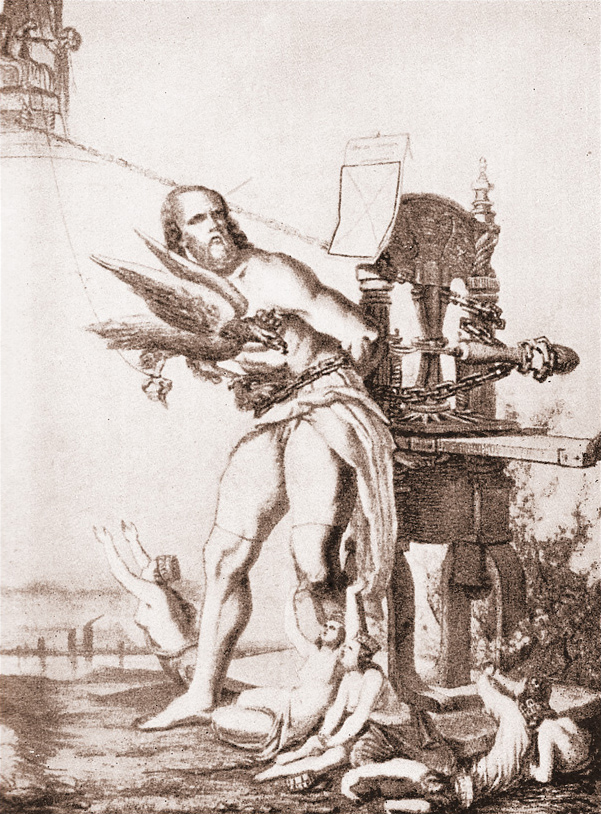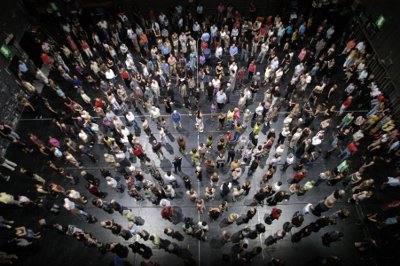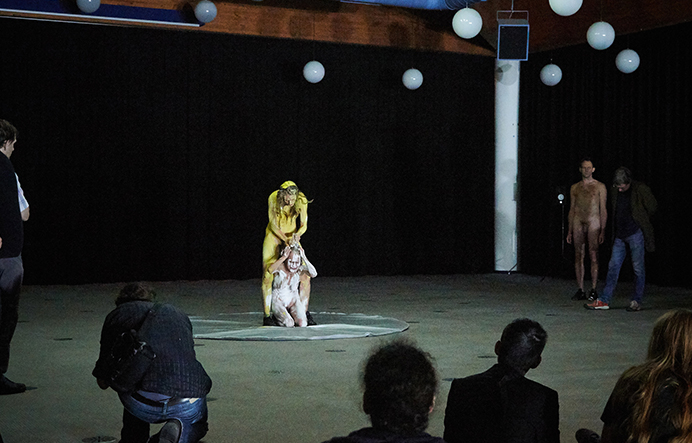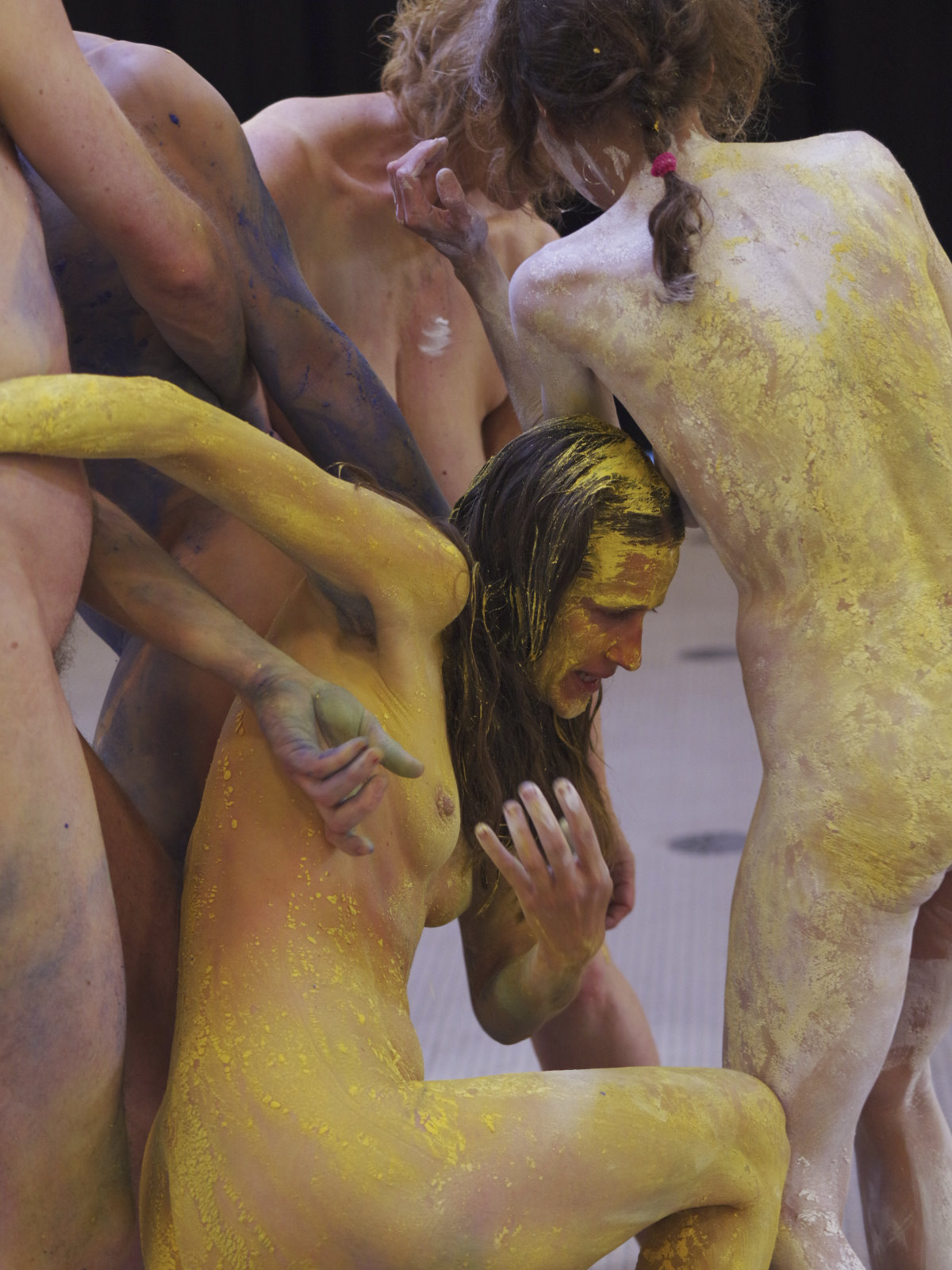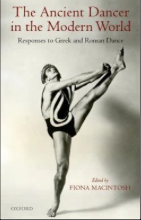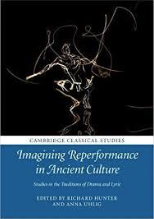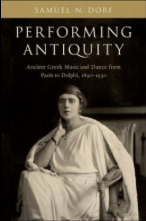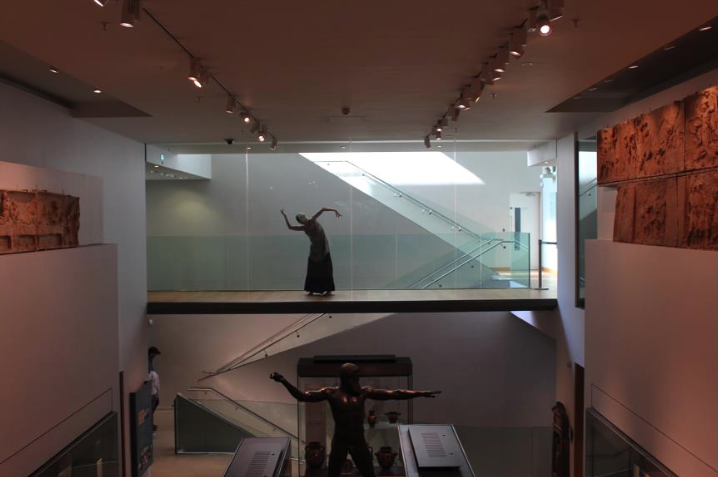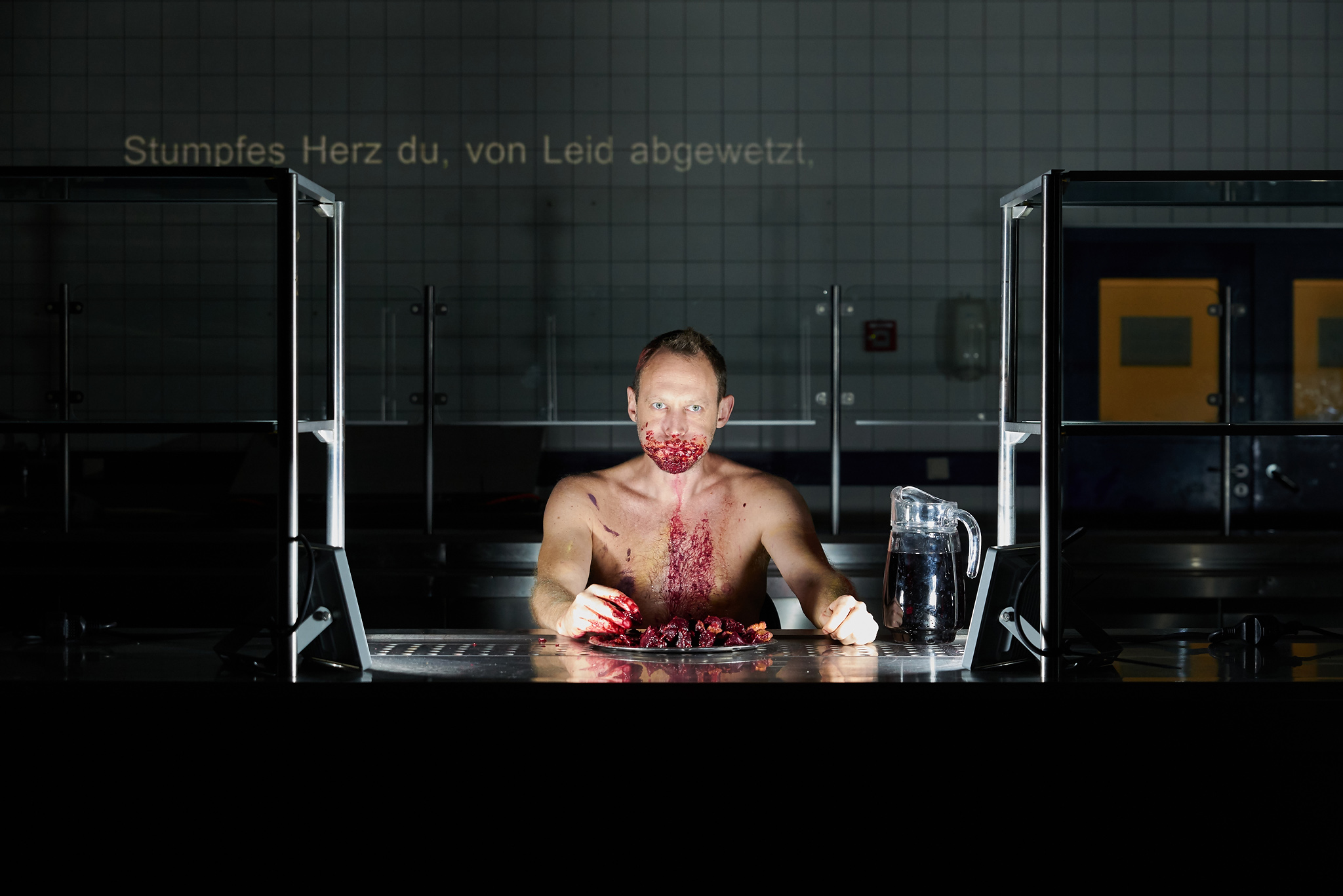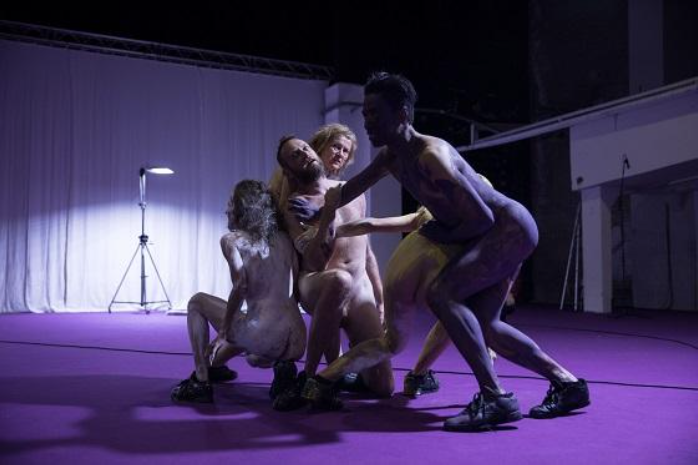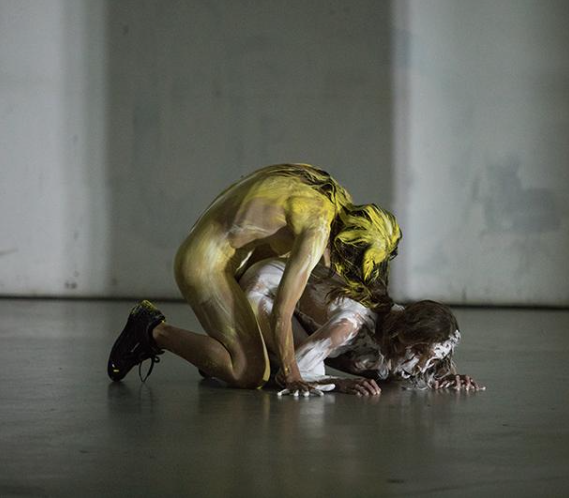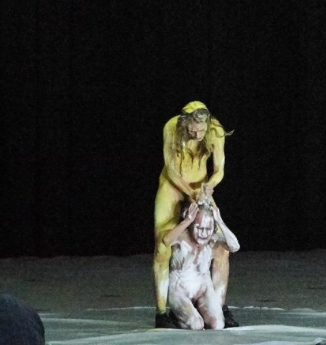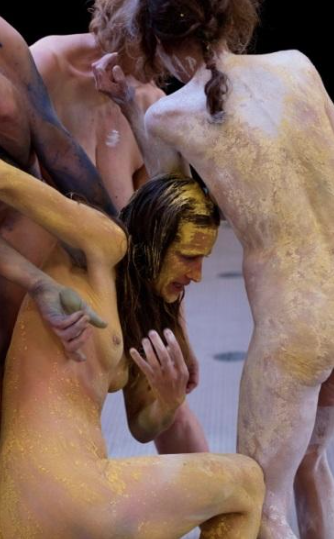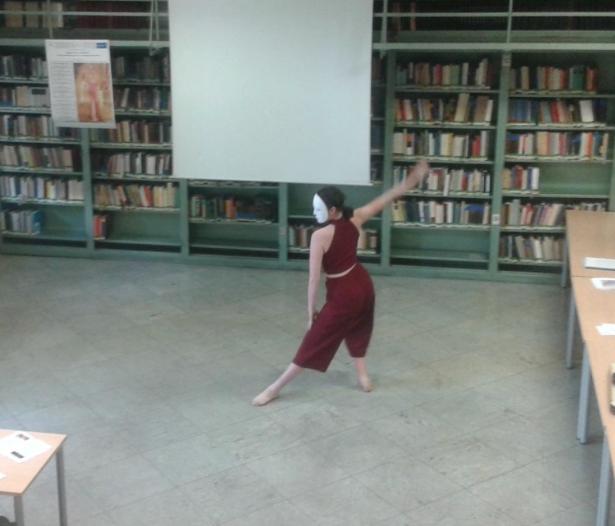zurück zur projektseite von THYESTES BRÜDER! KAPITAL – edith hall | when karl met lucius annaeus: seneca & marx in vienna |
based on a performance of THYESTES BRÜDER! KAPITAL in vienna, october 2019 When Karl met Lucius Annaeus: Seneca & Marx in Vienna by Edith Hall I was set an essay this week by Claudia Bosse, a brilliant Vienna-based theatre director with whom I worked a decade ago on Aeschylus’ Persians in Braunschweig, the city that gave A. Hitler German citizenship. Now she’s put on an astonishing production of Seneca’s Thyestes, which I attended with Vienna Latin Professor/Brexit victim Professor Peter Kruschwitz. But I felt like an undergraduate again because she has integrated a recital from Karl Marx’s Grundrisse, and asked me to make sense of the connection. Although Marx was classically educated at Trier Gymnasium and Bonn University, and he mentions practically every Greek and Latin author somewhere, Senecan tragedy (as far as I know) never features. 19th-century Germans all believed A.W. Schlegel, a specialist in ancient drama, who thought Seneca’s tragedy was an abomination--unperformable, tasteless bombast with zero dramatic, poetical or moral value. Schlegel should have seen Bosse’s production. Marx did engage with Senecan philosophy. His doctoral dissertation was on the Epicureans, but he had intended to write a post-doc thesis, a Habilitation, which discussed Stoicism as well. He did not like Stoicism for the same reasons I don’t: he thought it underestimated the power of human agency and over-estimated Fate; he also (like Hegel) thought Stoicism heralded the dominant, subjective, individuated ruling-class male ‘I’ of western identity which alienates humans from one another.
Marx loved theatre, constantly quoting Shakespeare (especially the pound-of-flesh scene in Merchant of Venice and Timon’s realisation that money corrupts) and near-obsessing on Aeschylus’ Prometheus Bound. And he frequently uses the classical metaphor of cannibalism, on which theme Seneca’s Thyestes is one long variation. His inaugural speech to the historic First International (1864) at Long Acre discussed the campaign of British workers to restrict the hours of labour, a campaign which had been bitterly opposed by industrial capitalists: they, ‘vampire-like, could but live by sucking blood, and children’s blood, too.’ Industrial Kapital devours the bodies of workers, even child labourers, draining them of their life blood in order to perpetuate its dysfunctional production and consumption. Marx was intimate with the legend of the family of Tantalus, who cannibalised his son Pelops, whose grandson Thyestes ate his own children, and whose great-grandson Agamemnon sacrificed his girl-child. Marx once wrote that the hordes of British soldiers dying in the Crimea were suffering all the pains of Tantalus without his guilt. On another occasion, when deriding the supposed reforms of bourgeois liberals, he wrote that Lord John Russell, ‘when he amused the House with a Reform Bill which he knew would prove another Iphigenia, to be sacrificed by himself, another Agamemnon, for the benefit of another Trojan War. He performed the sacrifice indeed in true melodramatic style, his eyes filled with tears’
Most importantly, Marx understood the ancient dramatists’ fascination with ignorance in connection with atrocity (Thyestes does not know what he’s eating any more than Oedipus knows whom he’s marrying) as expressing the idea of false consciousness. We all suffer delusions about the economic system we live under. They enable us to tolerate the atrocities it entails. So I ended my essay with one of my favourite sentences in world literature. In Rheinische Zeitung Marx wrote, ‘Ignorance is a demon which will, we fear, be responsible for many a tragedy yet; the greatest Greek dramatists were right when they depicted it, in the terrible dramas that deal with the royal families of Mycenae and Thebes, as tragic fate’. This is a significant reason, I believe, why ancient tragedy still resonates so much today, as the Vienna performance emphatically shows. Edith Hall is a British scholar of classics, specialising in ancient Greek literature and cultural history. She's a Professor in the Department of Classics and Centre for Hellenic Studies at King's College, London. Following a show of THYESTES BRÜDER! KAPITAL in vienna, she was a guest for an artist talk on "marx and cannibalism". |
| – edith hall – dr. laura gianvittorio-ungar | seneca, theatercombinat, and embodied philology – dr. laura gianvittorio-ungar (2) – constantin leonhard |
based on a performance of THYESTES BRÜDER! KAPITAL in vienna, october 2019 Seneca, theatercombinat, and embodied philology by Dr. Laura Gianvittorio-Ungar When Claudia Bosse asks classical scholars to collaborate with her, they usually respond well: Georg Danek (Universität Wien) participated to the Massakermykene project (1999-2000), Edith Hall (King’s College London), Sophie Klimis (Université Saint-Louis) and Georg Danek were involved in Persians (2006-2008), Sophie Klimis also collaborated within Phèdre (2008), and Edith Hall has recently commented on Thyestes Brürder! Kapital in a live talk and in her blog (http://edithorial.blogspot.com/2019/10/when-karl-met-lucius- annaeus-seneca.html). I can think of different reasons why classical philologists, myself included, may be particularly interested in Claudia Bosse’s work on ancient drama, and they go beyond the close attention which she pays to the language and even textual dimension of theatre. A fairly general reason is that reception has become hugely important to classical scholarship (and will grow even more important in the future); this, and the plain fact that re-performances of ancient drama play a major role in modern and contemporary Western theatre (especially in German-speaking areas: see E. Fischer-Lichte, Tragedy’s Endurance, OUP 2017) naturally draws classicists closer to stage artists who deal with Greek and Roman drama. A more particular reason which I am going to discuss is that the body-focused and carefully choreographed dramaturgy of Claudia Bosse resonates well with some present-day research trends in Classics. Persians, for instance, was quick to find its way into discussions about ancient choruses and their modern revivals in a volume edited by classicists (https://www.oxfordscholarship.com/view/10.1093/acprof:oso/978019967 0574.001.0001/acprof-9780199670574-chapter-20). Along the same lines, what follows shall argue that Thyestes Brüder! Kapital is congenial to today’s re-appraisal of Seneca’s tragedies as likely sources of inspiration for ancient dance and to practice-based approaches to Latin poems which, like Seneca’s, are imbued with kinaesthetic imagery. For a decade now, experts such as Helen Slaney, Alessandra Zanobi and Bernhard Zimmermann have been arguing that Seneca’s tragedies (like Ovid’s Metamorphoses) were probably re-worked and re-used as libretti for pantomime, a dance genre which gained huge popularity in the Imperial period and in which one masked actor-dancer danced stories from the mythical and tragic repertoire, playing all the characters himself. While the rich kinesthetic, bodily and sensory vocabulary of Seneca’s text substantially corroborates this view, observing how Seneca’s Thyestes has sparked Claudia Bosse’s choreographic thinking and how it reverberates through the body and gestural language of Thyestes Brüder! Kapital can enrich this scholarly notion with further practice-based insights. Thyestes Brüder! Kapital is committed to exploring possible relationships between body and text and to experimenting with ways to embody the text. The stage rendering of Thyestes’ cannibal meal, to which I will return later, may strike us as the most radical of these text embodiments, but is by no means an isolated case. For example, when the Fury coerces the ghost of Tantalus to bring ruin upon his own progeny, what in Seneca reads like the Fury’s animal excitement at her own schemes and the powerless, disgusted surrender of Tantalus (Thyestes 1-121) is rendered through the Fury’s (Rotraud Kern) eager rubbing and moving upon Tantalus (Lilly Prohaska), who is prostrated on his hands and knees and thus sexually exposed; tellingly, by the end of their duet the body friction has caused the neon- yellow body paint of the Fury and the ghostly white of Tantalus to mix and smear on each other’s bodies as a lasting visual reminder that Tantalus’ complicity has been extorted. The circumstance that the five actors also double as chorus members only multiplies their occasions for reflecting and counterpointing the text by means of formations, bearings and movements.
Coming to the reenacting approaches to ancient texts, the research which, superseding the 1990s HIPs (historically informed performances), is being carried out in the broad field of performance studies is currently inspiring classical scholars not only to investigate ancient theories and practices of re-performance, but also, with the help of performing artists, to tackle ancient texts which were composed or re-used for performance by means of practice-based research.
Finally awoken from the dream (especially dear to 20th century French scholars of ancient dance) that past performances can be faithfully reconstructed on the basis of textual and archaeological documents, today’s re-enactments draw inspiration from the surviving evidence of the past to create new performances which are not shy in sending non-ancient messages of, say, social and political interest. Marie-Louise Crawley, for example, in cooperation with the Oxford-based APGRD/Archive for Performance of Greek and Roman Drama (http://www.apgrd.ox.ac.uk/), has recently created and performed the durational dance work Likely Terpsichore? (Fragments) which, while inspired by ancient sources on Roman pantomime and by the kinaesthetic language of Ovid’s Metamorphoses, also re- narrates the story of four female mythical characters from a woman’s perspective - and through a woman’s body.
In many regards, Thyestes Brüder! Kapital can be understood as re-enacting Seneca. One might think of the juxtaposition of the cannibal meal of Thyestes and of the passage from Karl Marx’s Grundrisse which lays bare the complementarity of goods production and consumption, and their power to call into existence producers who also are consumers. On the one hand Marx’s words, recited by Juri Zanger from the top of a ladder and pouring down like a hail of bullets, rationalize the tragedy of Thyestes eating his own children in terms of producers turning into consumers; on the other hand, the ingesting and burping performance of Thyestes (Nic Lloyd), who gorges on some very red and splashy foods in a factory kitchen, literally gives body to the most visceral implications of Marx’s concepts. Paradoxically, this intertextual relationship becomes even more emphatic once the words are over and Juri Zanger sits speechless next to Nic Lloyd.
For obvious reasons, Thyestes Brüder! Kapital can elicit peculiar responses from spectators who are acquainted with Seneca’s Thyestes and encourage them to rethink the bodily, sensory and kinaesthetic aspects of the text. To mention just one example from my own experience, when the messenger (Alexandra Sommerfeld) recounted how Atreus killed and roasted his nephews to serve them to Thyestes, seeing how her body continued shaking in terror for minutes made me wonder about ancient performances and re-performances of Seneca’s messenger, who on the one hand says that his limbs are rigid with fear (so much so that he can hardly speak), on the other describes each action, gesture and movement of Atreus with painful accuracy and with engrossing slow-motion effects. Also, listening to how the messenger pronounced the word Atreus in deep guttural sounds, betraying an impulse to vomit, effectively tied in my acoustic imagery the notion of Atreus to that of some unspeakable organic matter which is equally hard to digest for producers, consumers and spectators.
|
– edith hall |
based on a performance of THYESTES BRÜDER! KAPITAL in vienna, october 2019 Dining and re-dining with Thyestes. Embodying Seneca’s tragedy in antiquity and today by Dr. Laura Gianvittorio-Ungar Abstract: When Claudia Bosse asks classical scholars to collaborate with her, they usually respond well: Georg Danek (Universität Wien) participated to the Massakermykene project (1999-2000), Edith Hall (King’s College London), Sophie Klimis (Université Saint-Louis) and Georg Danek were involved in Persians (2006-2008), Sophie Klimis also collaborated within Phèdre (2008) and Edith Hall has recently commented on Thyestes Brüder! Kapital in a live talk with the artists and spectators (Marx and Classical Cannibalism, Vienna, October 4th 2019) and in her blog (http://edithorial.blogspot.com/2019/10/when-karl-met-lucius- annaeus-seneca.html). I can think of different reasons why classical philologists, myself included, may be particularly interested in Claudia Bosse’s work on ancient drama, and they go beyond the close attention which she pays to the language and even textual dimension of theatre. A fairly general reason is that reception has become hugely important to classical scholarship (and will grow even more important in the future); this, and the plain fact that re-performances of ancient drama play a major role in modern and contemporary Western theatre (especially in German-speaking areas: see e.g. Fischer-Lichte 2017) naturally draws classicists closer to stage artists who deal with Greek and Roman drama. A more particular reason which I am going to discuss is that the body-focused and carefully choreographed dramaturgy of Claudia Bosse resonates well with some present-day research trends in Classics. Her Persians, for instance, was quick to find its way into discussions about ancient theatre, ancient choruses and their modern revivals in volumes edited by or with classicists (see Bosse 2009, Danek 2009, Fischer- Lichte 2013 and Bosse – Haitzinger 2016[1]). Along these lines, what follows shall argue that Thyestes Brüder! Kapital is congenial to today’s re-appraisal of Seneca’s tragedies as likely sources of inspiration for ancient dance and to practice-based approaches to Latin poems which, like Seneca's, are imbued with kinaethetic imagery. For a decade now, experts such as Bernhard Zimmermann (2008), Helen Slaney (2013) and Alessandra Zanobi (2014) have been arguing that Seneca’s tragedies –like Ovid’s Metamorphoses and other poems of the same period– were probably re-worked and re-used as libretti for pantomime, a dance genre which gained huge popularity in the Imperial period and in which one masked actor-dancer danced stories from the mythical and tragic repertoire, playing all the characters himself (Garelli 2007; Lada- Richards 2007; Webb 2008; Hall – Wyles 2008; Schlapbach 2018). This comparatively recent view defies the traditional one that Seneca’s tragedies were recitation-dramas and is substantially corroborated by the rich kinesthetic, bodily and sensory vocabulary of these texts. Indeed, since the late twentieth century, the stage reception of Seneca’s tragedies has been fascinated by the «hyperreality, conspicuous consumption and spectacular violence» of these texts and by the possibilities they disclose and prompt for stage renderings[2]. Today, observing how Seneca’s plays continue to spark choreographic thinking and the physical and gestural vocabularies of theatre and performance artists can enrich the scholarly notion that these plays were probably danced in antiquity with further practice-based insights – not (of course) to reconstruct lost ancient performances but to appreciate how performable Seneca’s texts are. In this regard, Thyestes, Brüder! Kapital is in good company: to mention just another recent example relating to Seneca’s Thyestes, one might think of Cicatrici, a piece staged by the Italian theatre group Kronoteatro in 2018 which (according to a discussion published in the previous issue of Dionysus ex machina) not only focused on bodily aspects but also displayed choreographic sensitivity and a number of scenes reminiscent of dance theatre[3]. Archaic blow (archaische Wucht) is a phrase which has recurred more than once in press reviews of Thyestes, Brüder! Kapital - with good reason[4]. Like other theatrical and choreographic works by Claudia Bosse, Thyestes, Brüder! Kapital also experiments with new forms of chorality and is conceived as an immersive/participative performance. The choral experiments all revisit traditional relationships between chorus and actors: the five actors who play Tantalus’ ghost, the Fury, Thyestes, Atreus and the messenger also double as chorus members (Fig. 1); in this latter capacity, they constantly seek bodily engagement with the text, and this engagement is emphasized by their being naked, by the use of body paint and by the alienating slowness of their movements. Moreover, at the pivotal moment when Thyestes is about to consume the cannibal meal of his own children, a further and larger chorus of children begins buzzing around the performance space and joins the actor-choreuts in what vaguely resembles a mass-choral recitative (mass-choral recitatives have had a special tradition in German-language re-workings of ancient drama since the Sprechchöre of Wilhelm Leyhausen). As to the immersive/participative performance, the audience is encouraged to explore, walk through and hence modify the performance space, thus constantly re- defining it. In Vienna, the performance space was a disused factory kitchen and canteen on the outskirts of Vienna (the tenth district has been home to the Viennese working class for many generations now) – a space which of course enriched the intertextual assonances which Bosse created between Seneca’s parental cannibalism and Marx’ cycle of production and consumption (see below). By walking through and casually sitting around the performance space, the spectators ended up intermingling with the choral performers and obviously interfering with their formations, movements and actions[5].
Thyestes Brüder! Kapital is particularly committed to exploring possible relationships between body and text and to experimenting with synesthetic ways to embody the text[6]. The circumstance that the five actors also double as chorus members only multiplies their occasions for reflecting and counterpointing the text by means of formations, bearings and movements. The stage rendering of Thyestes’ cannibal meal, to which I will return later, may strike us as the most radical of these text embodiments, but is by no means an isolated case. For example, when the Fury coerces the ghost of Tantalus to bring ruin upon his own progeny, what in Seneca reads like the Fury’s animal excitement at her own schemes and the powerless, disgusted surrender of Tantalus (Thyestes 1-121) is rendered through the Fury’s (Rotraud Kern) eager rubbing and moving upon Tantalus (Lilly Prohaska), who is prostrated on his hands and knees and thus sexually exposed (Fig. 2 and 3); tellingly, by the end of their duet the body friction has caused the neon-yellow body paint of the Fury and the ghostly white of Tantalus to mix and smear on each other’s bodies as a lasting visual reminder that Tantalus’ complicity has been extorted (Fig. 4).
Coming to the reenacting approaches to ancient texts, the research which, superseding the 1990s HIPs (historically informed performances), is being carried out in the broad field of performance studies is currently inspiring classical scholars to investigate ancient theories and practices of re-performance (e.g. Hunter – Uhling 2017; Spelman 2018), to reconsider practice-based approaches to classical antiquity as research approaches which complement the Altertumswissenschaften (e.g. Dorf 2018; Slaney 2019) and also, with the help of performing artists, to tackle ancient texts which were composed or re-used for performance by means of performance-based research. Finally awoken from the dream (especially dear to 20th century French scholars of ancient dance) that past performances can be faithfully reconstructed on the basis of textual and archaeological documents, today’s re-enactments link together archive and repertoire and draw inspiration from the surviving evidence of the past to create new performances[7]. Accordingly, reenactments of Greek and Roman dance try and derive knowledge from kinaesthetic engagement with literary and archaeological documents and are not shy in sending non-ancient messages of, say, social and political interest. To mention just two examples, both related to the APGRD/Archive for Performance of Greek and Roman Drama (http://www.apgrd.ox.ac.uk/), the Oxford-based project Ancient Dance in Modern Dancers seeks to make new sense of ancient sources on dance by performing and experiencing dance works inspired by them with the help of classical scholars, professionally-trained dancers and anthropologists (Fig. 5, see also http://podcasts.ox.ac.uk/ancient-dance-modern-dancers), and Marie-Louise Crawley has recently created and performed at the Ashmolean Museum the durational dance solo Likely Terpsichore? (Fragments) which, while inspired by the kinaesthetic language of Ovid’s Metamorphoses, also re-narrates the story of four female mythical characters from a woman’s perspective - and through a woman’s body (Fig. 6; cf. Crawley, forthcoming).
In many regards, Thyestes Brüder! Kapital can be understood as re-enacting Seneca. One might think of the juxtaposition of the cannibal meal of Thyestes and of the passage from Karl Marx’s Grundrisse which lays bare the complementarity of goods production and consumption, and their power to call into existence producers who also are consumers (Fig. 7 and 8). On the one hand Marx’s words, recited by Juri Zanger from the top of a ladder and pouring down like a hail of bullets, rationalize the tragedy of Thyestes eating his own children in terms of producers turning into consumers; on the other hand, the ingesting and burping performance of Thyestes (Nic Lloyd), who gorges on some very red and splashy foods, literally gives body to the most visceral implications of Marx’s concepts. The (organic) matter of the Pelopids and the (historical) materialism of Marx comments on each other. In this process, the two performers embody their respective texts in such a radical way that, paradoxically, intertextual relationships become even more emphatic once the words are over and Juri Zanger sits speechless next to Nic Lloyd in the brilliantly chosen space of the factory kitchen.
For obvious reasons, Thyestes Brüder! Kapital can elicit peculiar responses from spectators who are acquainted with Seneca’s Thyestes and encourage them to rethink the bodily, sensory and kinaesthetic aspects of the text. To mention just two examples from my own experience, when the messenger (Alexandra Sommerfeld) recounted how Atreus killed and roasted his nephews to serve them to Thyestes, seeing how her body continued shaking in terror for minutes made me wonder about possible ancient performances and re-performances of Seneca’s messenger, who on the one hand says that his limbs are rigid with fear (so much so that he can hardly speak), on the other describes each action, gesture and movement of Atreus with painful accuracy and with engrossing slow-motion effects. Also, listening to how the messenger pronounced the word Atreus in deep guttural sounds, betraying an impulse to vomit, effectively tied in my acoustic imagery the notion of Atreus to that of some unspeakable organic matter which is equally hard to digest for producers, consumers and spectators.
Footnotes |
– edith hall |
nach einer performance von THYESTES BRÜDER! KAPITAL in düsseldorf, september 2019 Reflexion von Constantin Leonhard Gerade erst betrat man den Vorraum des ehemaligen Kinos am Worringer Platz, lauschte dem Text "Opfer und Täter“ von Heiner Müller, da entkleiden sich direkt zwischen dem Publikum die fünf Akteure und betreten die sich öffnende Säulenhalle. Dieses Fleisch blickt uns direkt an und eröffnet dadurch den performativen Dialog, dessen Teil der Betrachter in der nächsten Zeit sein darf. Das gezielte Atmen bewegt die Körper zunächst langsam, dann erfährt man, wonach die Akteure auf der Suche waren. Sie ziehen sich Schreie aus verschiedenen Punkten ihrer Körper. Mark erschütternde, kreischende oder keuchende Reste von Schreien dringen durch die gewölbte und vielseitige Akustik der Botschaft am Worringer Platz.
Ich fühle mich zurückgeworfen auf allzeitige basale Gefühle, auf das Mensch sein an sich Neben dem Atem ist auch das Leid anwesend, dass fühlbar ist durch die Schreie der Performer und ihren komponierten Posen, die sie nun miteinander einnehmen. Sie berühren sich fast behutsam, erstellen Formationen, die auf die Historie des Menschen zu verweisen scheinen. Man sieht den Performern die jeweiligen Kontaktflächen der Haut förmlich an. Man meint fast erleben zu können, wie der zaghafte oder intensivierte Kontakt zum anderen Menschen als einzige Fluchtmöglichkeit vor dem Grauen existiert. Andeutend, anlehnend – sich gegenseitiger Existenz vergewissernd, in der Hoffnung um Unterstützung. Lilly Prohaska, die dem Publikum in der Säulenhalle am nächsten stand, wird nun von allen Seiten mit Farbe beworfen. Das Anspannen der Muskeln lässt den kalten Aufprall der Farbe bereits vor dem eigentlichen Ereignis erkennen. Dadurch blitzen die Aggression, die Wut, der Hass in dieser stellvertretenden Handlung/Tat auf. Diese Emotionen werden genauso als basale menschliche Eigenschaft aufgezeigt und man wird deutlich erinnert, wer für alles Leid verantwortlich ist. Nachdem die Absperrung zum Säulenfoyer nun auch für das Publikum geöffnet wurde, wagt sich dieses, Lilly Prohaska langsam folgend, hinein. Als Tantalus Geist kauert sie nun am Boden und schleudert Silbe für Silbe, aus dem antiken Seneca Text, um sich. Ich versinke zum ersten Mal in den Zeilen, bin gebannt. Wen die Brutalität des Textes nicht erfassen sollte, dann zumindest die fundamentale Weise, wie jeder Buchstabe gezielt abgefeuert wird und sich zur Sprache formt. Der Atem, die Stimme und der Körper mit seinen Muskeln erzeugen die Laute. Die Laute werden zum Wort, werden zur Bedeutung, werden zur Grundlage von Kultur, der Bestätigung des Menschseins. Die Verbindung zur Gegenwart etabliert sich somit durch das Vehikel des antiken Textes. Nicht nur über den Inhalt, sondern über die Sprache, das Sprechen an sich. Die im weitläufigen Hauptraum folgenden chorischen Passagen vereinigen Publikum und Akteure. Immer tiefergehend wird man selbst Teil des Textes, des performativen Dialogs, ein gemeinsames Abenteuer auf Augenhöhe. Nun, da wir gemeinsam unterwegs sind, tritt die Narration wieder aus dem Text hervor. Ich fokussiere wieder die Ungeheuerlichkeit des Textes, bei dem das Schwert bis zum Schaft in der Kehle steckt.
Der Satz: „Dass dir dein Königreich unter den Füßen wegsackt.“ bringt mich zum Lächeln. Rache, Wut, Blutlust stecken in uns. Das muss allgemein oder gerade für den zivilisatorischen Fortschritt erkannt und zugelassen werden. Die Gemeinschaft aus Performern und Betrachtern, die räumlich begann, sickert immer tiefer auf die Gefühlsebene.
„Ja, das war extreme Kunst“, höre ich beim Rausgehen jemanden sagen. Constantin Leonhard absolvierte den Master Szenische Forschung und studiert an der Kunsthochschule für Medien Köln. Er konzipiert Performances für urbane und theatrale Räume. Aus seiner ursprünglichen Arbeit am Theater entwickelt er Fragestellungen zum Verhältnis von Publikum, Zuschauer und Raum.
|
www.theatercombinat.com theatrale produktion und rezeption

